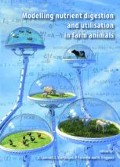Abstract
Our ability to describe differences between animal phenotypes is limited, especially in the context of applying nutritional models to predict performance of different genotypes in different environments. This may reflect the diffculty of measuring animal parameters relative to the ease of measuring feed characteristics. However, recent advances in on-farm technology now provide us with multiple time-series of reliably measured indicators of animal performance and status. This paper presents results from work to develop methods for extracting biologically meaningful features from such time-series that offer the potential for quantification of animal status at the level of the individual. One approach to feature extraction from time-series data is presented using milk yield data as an example. In this approach, the data are reduced to a smooth function using B-splines. These are very flexible in terms of approximating complex patterns, they can also be readily differentiated to provide derivatives that may in themselves be features with biological meaning such as milk yield acceleration. By imposing different degrees of smoothing it is possible to decompose the milk yield curve into components that describe the cow’s response to infection or nutritional challenge, as well as describing the phenotypic potential yield function of that cow. Each of these features relate to aspects of the cow’s potential and robustness. Features can also be combined across different measures, this is useful if the phenomenon we wish to describe is deemed to be latent with respect to the available measures. Taking mastitis as an example we present a proof of principle for combining time-series measures of different indicators (somatic cell count, electrical conductivity, and an enzyme in milk) to derive a latent quantity; degree of infection. These results are discussed in the context of achieving better descriptions of animal characteristics and their potential for driving nutritional models.
Access this chapter
Tax calculation will be finalised at checkout
Purchases are for personal use only
References
Bocquier, F. and Gonzáles-Garcia, E., 2010. Feeding practices for sustainable ruminant production facing environmental changes and the human food crisis. Animal 4: 1258–1273.
Bryant, J.R., López-Villalobos, N., Holmes, C. and Pryce, J.E., 2005. Simulation modelling of dairy cattle performance based on knowledge of genotype, environment and genotype by environment interactions: current status. Agricultural Systems 86:121–143.
Desnoyers, M., Giger-Reverdin, S., Duvaux-Ponter, C. and Sauvant, D., 2009. Modelling off-feed periods caused by subacute acidosis in intensive lactating ruminants: application to goats. Journal of Dairy Science 92:3894–3906.
Dumas, A., Dijkstra, J. and France, J., 2008. Mathematical modelling in animal nutrition: a century review. Journal of Agricultural Science 146:123–142.
Durbin, J. and Koopman, S.J., 2001. Time Series Analysis by State Space Methods. Oxford University Press, Oxford, UK.
Friggens, N.C., Chagunda, M.G.G., Bjerring, M., Ridder, C., Højsgaard, S. and Larsen, T., 2007. Estimating degree of mastitis from time-series measurements in milk: a test of a model based on lactate dehydrogenase measurements. Journal of Dairy Science 90:5415–5427.
Friggens, N.C. and Newbold, J.R., 2007. Towards a biological basis for predicting nutrient partitioning: the dairy cow as an example. Animal 1:87–97.
Højsgaard, S. and Friggens, N.C., 2010. Quantifying degree of mastitis from common trends in a panel of indicators for mastitis in dairy cows. Journal of Dairy Science 93:582–592.
Kamphuis, C., Sherlock, R., Jago, J., Mein, G. and Hogeveen, H., 2008. Automatic detection of clinical mastitis is improved by in-line monitoring of somatic cell count. Journal of Dairy Science 91:4560–4570.
Norberg, E., Hogeveen, H., Korsgaard, I.R., Friggens, N.C., Sloth, K.H.M.N. and Løvendahl, P.L., 2004. Electrical conductivity in milk: ability to predict mastitis status. Journal of Dairy Science 87:1099–1107.
Ramsay, J.O. and Silverman, B.W., 2005. Functional data analysis,1st. Springer, New York, USA.
Sloth, K.H.M.N., Friggens, N.C., Løvendahl, P.L., Andersen, P.H., Jensen, J. and Ingvartsen, K.L., 2003. Potential for improving description of bovine udder health status by combined analysis of milk parameters. Journal of Dairy Science 86:1221–1232.
Author information
Authors and Affiliations
Corresponding author
Editor information
Rights and permissions
Copyright information
© 2011 Wageningen Academic Publishers
About this chapter
Cite this chapter
Friggens, N.C., Codrea, M.C., Højsgaard, S. (2011). Extracting biologically meaningful features from time-series measurements of individual animals: towards quantitative description of animal status. In: Sauvant, D., Van Milgen, J., Faverdin, P., Friggens, N. (eds) Modelling nutrient digestion and utilisation in farm animals. Wageningen Academic Publishers, Wageningen. https://doi.org/10.3920/978-90-8686-712-7_4
Download citation
DOI: https://doi.org/10.3920/978-90-8686-712-7_4
Publisher Name: Wageningen Academic Publishers, Wageningen
Online ISBN: 978-90-8686-712-7
eBook Packages: Biomedical and Life SciencesBiomedical and Life Sciences (R0)


